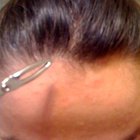Gray hair is considered a sign of growing older. It is true that nearly all human beings develop gray hair as they age. However, gray hair is not exclusively associated with aging. Many people begin to show significant graying hair as early as their 30s. In rare cases, premature gray hair is a sign of a problem that should be brought to the attention of a medical professional. However, the process of developing gray hair is inevitable.
The Process of Graying Hair
In actuality, there is no such thing as gray hair. All hair is either white or colored with varying shades of pigment or melanin. The melanin for hair is a specialized type, either dark pigment, called eumelanin, or light pigment, called phaeomelanin. These light and dark shades blend together to produce a wide range of colors. What appears to be graying hair is actually the process of more white hair replacing pigmented hair. When a majority of the hair on a person's head is white, the hair appears gray. When hair has lost all its pigment, it appears white.
Aging
The process of hair losing its natural pigment normally begins in a person's 30s and accelerates as he ages. According to a 2005 report published in the The Journal of Investigative Dermatology, half of all human adults are at least 50 percent gray by the age of 50. Caucasians tend to show gray hair most quickly, followed by Asians and those of African descent. Some blonds may appear to show less gray, since the white hairs blend in more closely with light hair.
Genetics
When a significant amount of gray hair appears before the age of 20 in Caucasians or age 30 in African Americans, the condition is known as premature graying, according to Jerome Z. Litt, M.D., an assistant clinical professor of dermatology at Case Western University in Cleveland. Premature graying is usually a result of genetics, or the natural predisposition to demonstrate a particular trait.
Medical Conditions
Some medical conditions can cause gradual or sudden graying of the hair, including vitiligo, which also causes a loss of pigment in the skin; alopecia areata, an autoimmune condition which also causes patchy hair loss; thyroid disease; a rare condition known as pernicious anemia in which blood cannot absorb vitamin B-12. When graying hair is caused by medical conditions, successfully treating the disorder usually results in the hair returning to its normal color.
Vitamin Deficiency
Graying hair can also be caused by a deficiency in vitamin B-9, commonly known as folic acid. Folic acid deficiency can be occur as a result of liver disease, alcohol abuse, dialysis and even during pregnancy and breast feeding. As with medical disorders that cause or exacerbate the process of graying hair, correcting folic acid deficiency usually results in a gradual return of the natural pigment of the hair.
Misconceptions
There is no truth to the old wives' belief that plucking one gray hair will cause 10 new gray hairs to grow back to replace it. There is also little scientific evidence to support the widespread belief that stress causes gray hair. There is no known medical treatment that will reverse the normal process of graying hair, despite the claims of many supplements and topical applications offered for sale.
Related Articles

Facts on Natural Hair Changing Color

Can Supplements Reverse Gray Hair?

How Does Facial Hair Grow Get Lighter ...

How Are Hair Colors Inherited?

Stages of Underarm Hair

Fraxel Laser Treatment Dangers

Can Drinking Nettle Tea Reduce DHT ...

Chemicals That Stop Testosterone ...

How to Tweeze Hair on Your Head

What Are the Causes of Hair Shedding in ...

Does Tweezing Your Upper Lip Make Your ...

Shampoos to Get Rid of Gray Hair

Dominant & Recessive Hair Colors

The Best Colors for Dying White Hair

Zinc & Gray Hair

Can Hair Dye Cause Severe Itching of ...

Chlorella and Hair Loss

About Hair Bleaching

The Effects of Vitamin-D Deficiency on ...

Chasteberry for Acne
References
Writer Bio
Chris Blank is an independent writer and research consultant with more than 20 years' experience. Blank specializes in social policy analysis, current events, popular culture and travel. His work has appeared both online and in print publications. He holds a Master of Arts in sociology and a Juris Doctor.